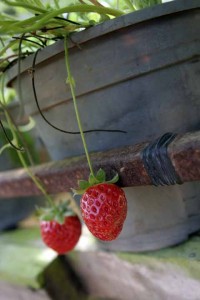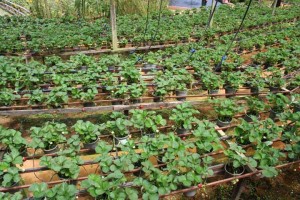
flickr
Strawberries are derived from a flowering plant in the rose family, Rosaceae. There are more than 20 different types of strawberries and a whole lot more hybrids and cultivars. The most common type of strawberries grown are the Garden strawberry. They are plants that can be grown in containers outdoors as well as indoors. For successful strawberry cultivation, you will need to choose the right cultivar, plant them correctly and provide them with at least six to eight hours of sunlight a day.
Selecting a Strawberry Variety
There are different types of strawberries to choose from when deciding which cultivar you want to use. It depends on the timing of the harvest that you prefer, growing conditions, as well as the climate that you live in. There are basically three main categories of garden strawberries:
June Bearing – which produces one large crop annually during the spring
Everbearing – produces 2 to 3 crops during the spring, summer and fall
Day Neutral – produces continuously throughout the growing season; yield not as large as June Bearing variety.
The planting zone in your area can affect the timing you can plant you strawberries. For areas with warmer climates, strawberries can be planted in the fall or early winter. Otherwise they should not be planted until the beginning of spring when soil can be worked on. Always plant only after the frost has passed.
Red alpine strawberries (which is an everbearer) are best grown indoors because they are tolerant with shady conditions, while the Brighton variety can be cultivate in hanging baskets. Regardless whether you prefer indoor or outdoor gardening, consult the local greenhouse to see which varieties suits your area.
Planting Strawberries Indoors in Containers
Prepping the Soil
Once you\’ve decided on the type of strawberry to plant, you should take steps to prepare the soil. Soil pH of 5.3 to 6.5 is suitable for strawberries, but it is not uncommon for strawberries to grow in soils that have a slightly higher or lower pH level than this range. You may also want to add some controlled-release fertilizer to the soil before planting.
Prepping the Plant
Trim off older leaves from the plant and remove all flowers and runners. Trim the roots so that they are about 4 to 5 inches in length. Remove any damaged area and place the roots for an hour in water before you plant. Plant the strawberry with the crown of the plant level with the soil\’s surface. Allow the roots to fan out.

figure 1
Using Strawberry Pots
Strawberry pots can hold one to three plants at the top and are designed with pockets in the sides that can hold any runners that developed as the plant matured.
Refer to Figure 1 for a visual guide on how to plant your strawberry pot.
You will need
- One PVC pipe capped at one end
- A drill
- Potting soil
- A strawberry pot.
Method
- Cut the pipe to length so that it will sit flush with the strawberry pot\’s rim.
- Drill 1/8″ diameter holes with a spacing of one inch apart on opposing sides of the pipe.
- Fill the pot with soil half way then insert the pipe with its cap end down, into the center of the pot.
- Add the remainder potting mix.
- Plant each pocket with a strawberry plant.
- Plant two to three plants at the top
- Soak the soil well and water the pot by inserting a funnel into the pipe and pour water into it. Make sure that the water is distributed evenly through the pot.

flickr
Caring for the Plant
During the first six weeks after planting, remove all blossoms on ever-bearing and day-neutral plants to encourage more root and foliage growth instead of flowering and fruiting.
Water – water the plants every day until the growing season. 1 to 2 inches of water per week encourages the growth of juicy fruits. This is especially important when the fruit is forming.
Fertilizer – Make sure that the container is free from weeds. You do not want weeds to compete with your strawberry plant for nutrients. Fertilize them once a month, until it starts flowering, then increase fertilization to once every 10 days until harvest season is over. Use a fertilizer high in potassium.
Sunlight – Make sure that the plants get at least six hours of sunlight a day for a harvestable yield, the more the better it is. If you have your strawberries in hanging baskets, rotate them so that all plants attain optimal lighting.
Pests and Insects – Aphids and red spider mites are a strawberry plant\’s worse nightmare. Powdery mildew can also become a problem. Treat it with adequate amount of the right pesticide and fungicide as required.
It won\’t be long after you are rewarded with juicy fresh strawberries for your picking.
More Reading:
Growing Strawberries: What to Do Throughout The Seasons:
http://www.doityourself.com/stry/growing-strawberries–what-to-do-throughout-the-seasons
Strawberry Planting: When, Where, and How-To:
http://www.doityourself.com/stry/strawberry-planting-when-where-and-howto
Strawberries: http://gardening.about.com/od/fruitsberriesnuts/a/Strawberries.htm
How to Plant Strawberries Indoors: http://thegardenersrake.com/how-to-grow-strawberries-indoors-in-a-strawberry-pot

